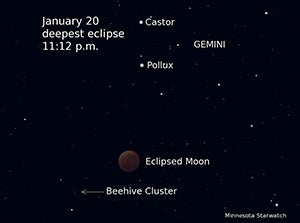Minnesota Star Watch: Venus and Jupiter dance
Published 7:01 am Saturday, December 29, 2018
A University of Minnesota feature by Deane Morrison
January opens on the first steps in a graceful predawn dance between Venus and Jupiter. Not to be outdone, the evening sky answers with a total eclipse of a “supermoon” in mid-month.
As the sky awaits the first sunrise of 2019, we’ re treated to a crescent moon hanging above bright Venus, with Jupiter far below. Off to the right of Jupiter shines Antares, the red heart of Scorpius. Over the next three mornings, the moon thins as it drops past Venus and then Jupiter. On the 4th, look 45 minutes before sunrise to see a skinny old crescent just above the east-southeast horizon.
After the 6th, Venus moves slowly nearer to the rising sun. But Jupiter climbs away from it, thanks to Earth catching up to Jupiter in the orbital race. The two planets pass each other on the 22nd. Starting on the 30th, the moon repeats its early-January performance, this time sweeping by Jupiter first. Don’ t miss the show on the 31st, when a waning crescent moon rises next to Venus. Late in the month, you may spy Saturn low in the southeast as the ringed planet, like Jupiter, begins a climb into the morning sky.
The moon celebrates its first full phase of the year by plowing through Earth’ s shadow in a spectacular lunar eclipse. On the night of Sunday, the 20th, the moon will be very close and appear large and bright—hence its supermoon status. It starts to disappear into the dark inner shadow, or umbra, at 9:34 p.m., with totality beginning at 10:41 p.m. and the moon in deepest eclipse at 11:12 p.m. During or close to totality, grab some binoculars and look below and east of the moon for the lovely Beehive star cluster.
Totality ends at 11:43 p.m., when the first silver sliver peeks out from the curtain of Earth’ s shadow. The last vestiges of umbra drop away at 12:51 a.m. on the 21st.
On January 2nd, at 11:20 p.m., Earth reaches perihelion, its closest approach to the sun. We’ ll be 91.4 million miles away, only a million and a half miles closer than average, so of course we feel no extra warmth. However, if winter gets you down, you can thank the date of perihelion for the fact that winter is our shortest season.
That’ s because Earth’ s orbit is an ellipse, not a circle, and when a celestial body follows an elliptical orbit, it always moves fastest when it’ s closest to the body it orbits, and most slowly when it’ s farthest away. Earth is farthest from the sun and slowest in early July. But it hustles through the part of its orbit it’ s in now. The difference in speed gives us winters that are about four and a half days shorter than our summers.
The University of Minnesota offers public viewings of the night sky at its Duluth and Twin Cities campuses.



